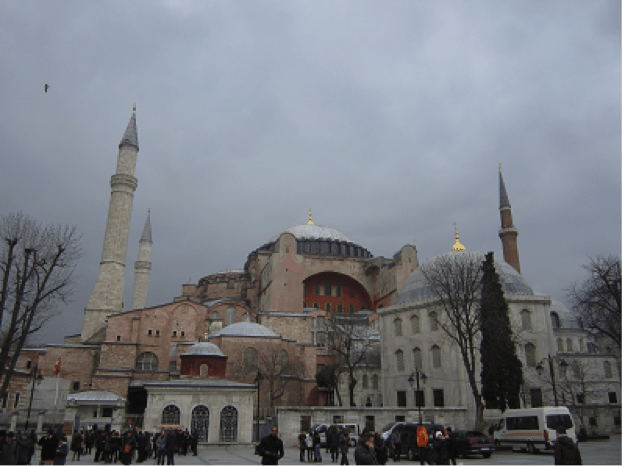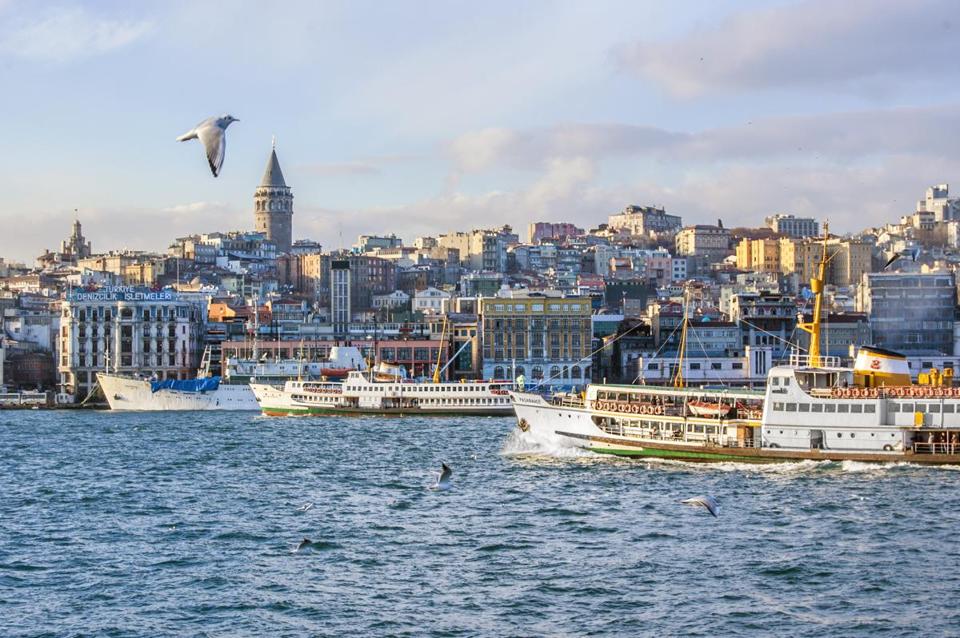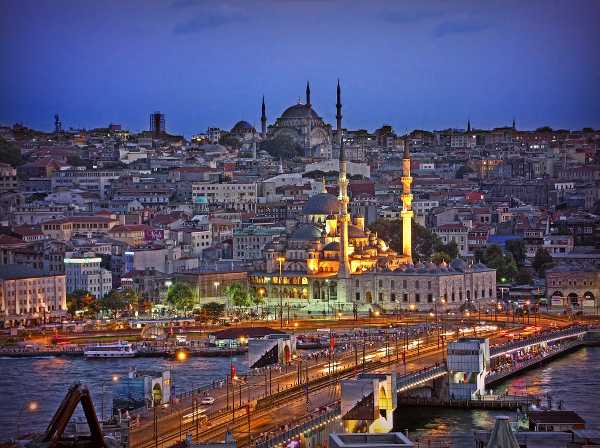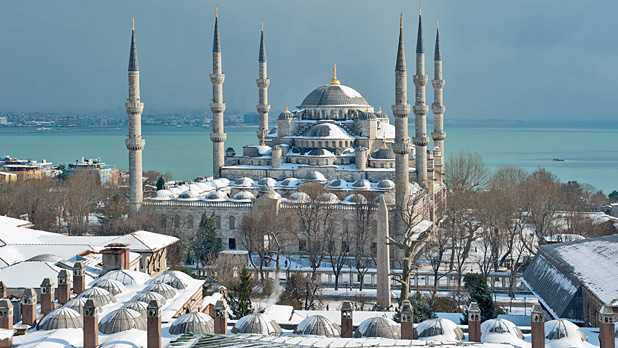By Chris Mayer | 03/04/13
It’s Istanbul, not Constantinople, as the song goes. In this history is an omen for any powerful state (read: the U.S.). A somewhat obscure essayist knew all about it back in 1959. His little book deserves wider circulation. Below, we’ll take a look.
Constantinople was once the seat of a vast, rich empire. The successor to Rome, it ruled over a land that stretched from the Caucasus to the Adriatic, from the Danube to the Sahara. The Dark Ages were dark only if you ignore the flourishing civilization on the Bosporus.
Historian Merle Severy writes: “Medieval visitors from the rural West, where Rome had shrunk to a cow town, were struck dumb by this resplendent metropolis.” There were half a million people here. Its harbors full of ships, “its markets filled with silks, spices, furs, precious stones, perfumed woods, carved ivory, gold and silver and enameled jewelry.”
This civilization lasted for a thousand years.
Actually, it lasted for 1,123 years and 18 days after Constantine the Great made the city his new Christian Rome. On May 29, 1453, Constantinople fell to the Turks.
The Hagia Sophia — once a cathedral, then a mosque, now a museum — the bones of a dead civilization.
Renamed Istanbul, the city would serve as the seat of yet another great empire, the Ottoman. And this one would last nearly five centuries. In the 16th and 17th centuries, the Ottoman Empire was perhaps the most powerful state on Earth. It was on one heck of a roll. After Constantinople, the Ottomans took Athens in 1458. Then it was on to Tabriz (1514), Damascus (1516), Cairo (1517), Belgrade (1521), Rhodes (1522), Baghdad (1534), Buda (1541), Tripoli (1551) and Cyprus (1571).
They almost took Vienna. The powers of Western Europe drew the line in the sand there. Interesting to think what would’ve happened if the Turks took Vienna. All of Western Europe would be at their feet. If they had succeeded, perhaps the majority of Europeans would be answering the call to prayer, echoing from the minarets of cathedrals-turned-mosques…
Your editor inside the courtyard of the famed Blue Mosque…
Yet the Ottoman Empire, too, would crumble. It was constantly at war. By one historian’s reckoning, the longest period of peace was just 24 years in nearly six centuries of reign.
In 1923, with the founding of the Republic of Turkey, Ankara became the seat of government. As historian John Freely notes: “For the first time in 16 centuries, the ancient city on the Golden Horn was no longer reigning over a world empire with only the presence of the monuments to remind one of its imperial past.”
It is not hard to think of the U.S. in the context of these great powers.
*** Enter Chodorov
One of the books I had tucked in my bag that I read while in Turkey was Frank Chodorov’s The Rise & Fall of Society. This is a slender 168-page book by a great, if somewhat forgotten, essayist and editor. It gives a tightly reasoned answer to the question “Why do societies rise and fall?”
Chodorov’s thesis is that “every collapse of which we have sufficient evidence was preceded by the same course of events.”
The course of events goes like this: “The State, in its insatiable lust for power, increasingly intensified its encroachments on the economy of the nation…” and finally gets to the point where the economy can no longer support the state at the level it is accustomed to. Society can’t meet the strain, so “society collapsed and drew the State down with it.”
The pattern is always the same, regardless of size or ideology. The state can grow only by taking. “Since the State thrives on what it expropriates,” Chodorov writes, “the general decline in production which it induces by its avarice foretells its own doom.”
Chodorov bases much of his thesis on what he calls “the law of parsimony.” In essence, it is simply that people try to get the most satisfaction with the least amount of effort. It is a natural law of human behavior.
The law does not say they always achieve this goal, of course. It simply says it is what people try to do. Cooperation with others enhances the ability to satisfy. “Sociability thrives on the mutual profits of cooperation,” Chodorov writes, “and when we observe how an acquaintance ripens into friendship as the mutually created wage level rises, it is hard to tell which is cause and which is effect.” The marketplace is the binding of society and coexistent with it. No marketplace, no society. No society, no marketplace.
Now enter the state (whose origins Chodorov covers, but I will pass over here). The state is also made up of men. They, too, are subject to the law of parsimony. So they will make efforts to enlarge and better their position, which they can only do by confiscation (taxes, fines, etc.).
“Rome had its make-work programs, its gratuities to the unemployed and its subsidies to industry,” Chodorov writes. “These things are necessary to make confiscation palatable and possible.”
Another tourist hot spot, the Topkapi Palace, where the sultans lived decadently… at the expense of the taxpayers, of course.
How, by various ways of obscurantism and promises, the state is able to grow ever larger and more powerful is the main narrative of the book. Chodorov’s writing is honey smooth and his ideas reflect the learning and thought of a lifetime pondering such questions. (He was 72 at the time of publication.)
Though the book is a slender, easy read, it is packed with ideas. Chodorov, long known as a great teacher, has a gift for stating ideas simply in well-turned phrases. (My copy has plenty of highlighted passages.) And his defense of the network of voluntary exchange that we call a marketplace is downright eloquent.
One of my favorite chapters is “The Humanity of Trade.” There he writes about how the markets make it possible that the fish of the sea reach the miner’s table. Northerners enjoy tropical fruits because they can trade for them with goods and services that make life in the tropics easier.
“It is by trade that the far-flung warehouses of nature are made accessible to all the peoples of the world,” Chodorov writes, “and life on this planet becomes that much more enjoyable.” Trade not only improves our material wealth. Trade brings an influx of ideas, stories of interesting people and other cultures that in turn enrich our own literature, arts and ‘operatic repertoire.’”
Reading Chodorov, one can’t help but marvel at the powers of voluntary social cooperation and exchange. Yet there is this never-ending cycle of the rise and collapse of societies. Can we break this depressing cycle?
Chodorov gives an answer in the last chapter, titled “One Can Always Hope.” He writes: “None has as yet been discovered. Nevertheless, the search for a formula for the ‘good society’ has never been abandoned, hope being what it is, and out of the laboratory of the human mind has come congeries of utopias.”
A bleak ending, perhaps. But Chodorov leaves out the possibility that in the U.S., at least, it may be possible to impede the state. Americans still have “a folklore of freedom.” This libertarian tradition may yet be revived. “It is worth a try,” Chodorov writes. He ends his book with a sentence that captures the most critical idea of all: “The will for freedom comes before freedom.”
The Rise & Fall of Society is a little treasure of a book. Laissez Faire Club (of which I am a member) made it a selection of the month recently and prompted me to pick up a copy. I have all of Chodorov’s books — The Income Tax: Root of All Evil, One Is a Crowd: Reflections of an Individualist, Out of Step: The Autobiography of an Individualist and the posthumous collection, Fugitive Essays. Chodorov is among my favorite libertarian writers, a list that includes Murray Rothbard, H.L. Mencken, Albert Jay Nock and Lysander Spooner. For whatever reason, I had never read The Rise & Fall, but it is classic Chodorov and worth a read.
You can pick up a copy here. (http://lfb.org/shop/economic-systems/the-rise-and-fall-of-society/)
Istiklal Caddesi on a Tuesday afternoon, a bustling street of shops, restaurants and plenty of people.
As I walked around Istanbul, admiring the architecture — the bones of a lost civilization — I still managed to feel optimistic. Life in Istanbul is, in fact, far better for the typical person than it was at the height of any of the dead empires. In material wealth, people live longer and far healthier lives today. They are literate and technologically more advanced. They have greater leisure and access to a wealth of ideas unimaginable in the old days.
This is despite the ugliness of states. And that, after all, is some consolation for the ideas of human progress and liberty.
Sincerely,
Chris Mayer
Original article posted on Laissez-Faire Today
Chris Mayer
Chris Mayer is managing editor of the Capital and Crisis and Mayer’s Special Situations newsletters. Graduating magna cum laude with a degree in finance and an MBA from the University of Maryland, he began his business career as a corporate banker. Mayer left the banking industry after ten years and signed on with Agora Financial. His book, Invest Like a Dealmaker, Secrets of a Former Banking Insider, documents his ability to analyze macro issues and micro investment opportunities to produce an exceptional long-term track record of winning ideas. In April 2012 Chris will release his newest book World Right Side Up: Investing Across Six Continents.
Read more: In Istanbul:The Rise & Fall of Society http://dailyreckoning.com/in-istanbul-the-rise-fall-of-society/#ixzz2MeAwNwey






